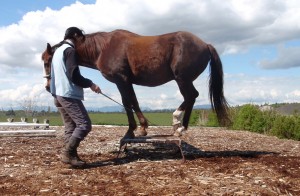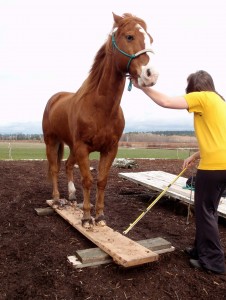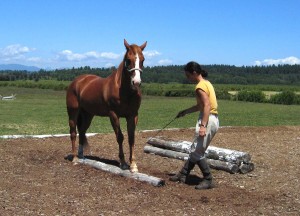How to H.E.M. – Help, Explain and Motivate your horse – Part 12
|
|
Helfen, Erklären und Motivieren – Teil 12
|
Whip and rope aids:
- Your whip and the rope in your hand become a part of your body – this is how the horse will see it. As the whip is merely the prolongation of your arm to caress and touch him in places, where you would otherwise not be able to reach, he will of course not fear it. It is not used to punish!
- Your touching aids have to be accurate – in degree of intensity as well as location. A certain “touching spot” on the horse’s body means one thing and only that one thing. (Tapping the cannon bone means, “lift your foot”, a touch on the shoulder means “lift your leg for the Spanish step”, and so on). Be consistent with these touching locations, otherwise you confuse your horse.
|
|
Gerten- und Seilhilfen:
- Ihre Gerte und ein Seil in Ihrer Hand werden zu Bestandteilen Ihres Körpers – so wird das Pferd es sehen. Da die Gerte nur die Verlängerung Ihres Armes ist und zum Streicheln wie zum Touchieren an Körperteilen benutzt wird, die man sonst nicht erreichen könnte, hat das Pferd keinen Grund sie zu fürchten. Sie wird nicht zum Bestrafen eingesetzt!
- Ihre Touchierhilfen müssen akkurat sein – im Grad der Stärke sowie an der richtigen Stelle. So ein “Touchierpunkt” an einer bestimmten Stelle des Pferdekörpers bedeutet eine Sache und nur diese Sache. (Antippen des Röhrbeins bedeutet “heb den Huf“, Antippen der Schulter bedeutet “spanischer Schritt”, usw.) Seien Sie sehr genau und konsequent mit diesen Touchierpunkten, damit Sie Ihr Pferd nicht verwirren.
|
 Peter follows my touching aid precisely – I can place his foot accurately |
- Placing a foot precisely on touching aid contains several components. Tapping means “lift”, whereas a slight tickling with the whip means, “you’re almost ready to land, just not exactly the right spot” – combined with a directional aid on the rope. Resting the whip means, “here is correct”, and, combined wit the voice aid “fini!” it means: “now you can land!”
- The rope and halter are used as an directional aid – a slight tug tells him to come forward a bit, to balance to the right or left a bit more, and so on. Shaking the rope means “slow down!” or “stop!” Both halter and rope are of course never used to pull, they communicate by slight short tugs or vibrations. Remember that it is the release that teaches! (This is of course true for all aids: releasing the aid means “you have done the right thing” and praise follows.)
|
|
- Einen Huf genau auf Touchierhilfe zu plazieren enthält mehrere Elemente. Antippen heißt „heb an!“, während ein leichtes Kitzeln mit der Gerte heißt „du kannst fast landen, nur noch ein bißchen hier herüber!” – kombiniert mit einem leichten Zupfen am Seil in die günstigere Richtung. Anlegen der Gerte heißt dann „hier ist es richtig“ und, kombiniert mit der Stimmhilfe „fini!“, bedeutet es „jetzt kannst du den Huf absetzen“.
- Das Halfter oder Seil wird also als Richtungsweiser eingesetzt – Zupfen heißt „komm ein bißchen vor“, rechts oder links hin hilft es der Balance usw. Schütteln heißt „mach langsam!“ oder Stopp! Beide, Seil und Halfter, werden nie zum Ziehen benutzt, man kommuniziert durch leichtes Zupfen oder Vibrieren. Vergessen Sie nie, daß es das Nachgeben ist, welches etwas lehrt! (Das betrifft natürlich alle Hilfen: Das Aussetzen der Hilfe heißt immer “jetzt war es richtig!” und das Lob folgt.)
|
 By tugging slightly on the halter you give the horse directional aids |
- Both rope and whip aids can later be reduced to finger-signs, but even when whip and/or rope are not there any longer, your movements remain the same – and the horse will still “see” the rope and whip and follow them.
- Below: My body language here says: “follow me!”
|
|
- Gerten- und Seilhilfen werden später beide auf Finger- oder Gertenzeichen reduziert, aber selbst wenn diese Hilfsmittel nicht mehr vorhanden sind, bleiben Ihre Bewegungen genau die selben – und das Pferd „sieht“ und folgt Seil und Gerte immer noch.
- Unten: Meine Körpersprache sagt hier: „folge mir!“
|
 Round your body and move backward to make the horse follow
|
- A horse can only understand what your commands or aids mean by association with a prompt reinforcement. If you do not tell him that he did the right thing within half a second, he does not mentally connect his “action” with the reward, so no learning takes place.
- The horse always “associates” the last two things, which just happened: He lowered his head on your cue – your reinforcement came too late – in the meantime he rubbed his nose on his cannon bone. Presto! He “deduces” that the praise came for rubbing his nose – and you have reinforced a behaviour, which can become a nuisance when riding… The timing of your praise is just as important as the timing of your aids!
Continue in part 13:
Analyse the problem in all its components!
|
|
- Ein Pferd kann nur durch Assoziieren mit einer sofortigen Verstärkung verstehen, was Ihre Kommandos oder Hilfen bedeuten. Wenn es nicht durch Ihr Lob innerhalb einer halben Sekunde erfährt, daß es das Richtige getan hat, dann „verknüpft“ es mental nicht diese „Aktion“ mit der Belohnung – und daher lernt es nichts.
- Das Pferd assoziiert immer die letzen beiden Dinge, die gerade geschehen sind: es hat auf Ihre Touchierhilfe hin brav den Kopf gesenkt – die Verstärkung kommt zu spät – und mittlerweile hat es seine Nase am Bein gerieben. Presto! Es „folgert“, daß die Belohnung dafür war, daß es seine Nase reibt – und Sie haben ein Benehmen verstärkt, welches beim Reiten sehr störend werden kann! Der genaue Zeitpunkt einer Verstärkung ist genauso wichtig wie das Timing der Hilfen!
Weiter gehts im nächsten Teil:
Analysieren Sie das Problem in allen seinen Bestandteilen!
|




